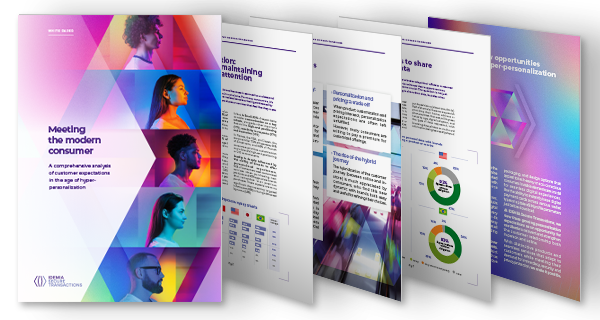Delivering top-of-wallet payment cards with advanced personalization

Hyper-personalization aims at delivering individualized and deeply customized experiences to consumers that resonate with their lifestyle, enabling businesses to enhance engagement and drive loyalty. This approach is gaining increased momentum with the new promises that AI brings in terms of data analysis and reinventing dialogue with consumers. But hyper-personalization is not a new, and there’s much more to it than meets the eye. Let’s explore its many facets.
When we think about “hyper-personalization,” we probably think about offers and products that are adapted to the needs and values of individual customers. These are offers that reflect their personality or enable them to display their uniqueness or belonging to a group. This is typically the approach taken by major sports shoe brands such as Nike and Adidas, who give their customers the opportunity to co-create their pairs of sneakers with different color combinations and inscriptions of their choice.
The variety of colors and options offered by many automakers to enable car owners to define the design and functionalities of their new vehicle is also a good example—as exemplified by Tesla, which offers its customers the possibility of choosing the color of their future vehicle and its interior, the style of the wheels, the shape of the steering wheel, the number of seats, the acceleration power, and even offers them the option of testing autonomous driving functionalities.
Similarly, FinTechs, GAFAM and banks are now catering their card offers to their customers, by offering payment cards with innovative card bodies, designs and functionalities: metal cards engraved with a custom-made pattern, translucent cards or cards with colored edges, recycled material cards, OLED cards that light up during contactless transactions, biometric cards… the list goes on. This attention to card design is also gaining traction with major automakers, who see NFC key cards as a new emblem to put in the hands of car drivers.
Beyond the development of a hyper-modular offer and a very wide range of options, it’s also in the interaction with the customer through which the perception of the brand’s attention to consumer expectations is created. Out-of-the-ordinary packaging can create this premiumization effect, illustrated by the success of unboxing videos for luxury products, athletic shoes1, smartphones2 and even… payment cards3.
In some cases, some providers intentionally keep their deeply individualized services under the radar— customizing their services to work perfectly with each customer device. Paradoxically, the aim is for consumers to remain unaware of this hyper-personalization effort, as the goal is to deliver the smoothest, most transparent experience imaginable. Mobile operators who have to offer their services across the wide variety of smartphones and other connected devices in the field are quite familiar with this challenge. For decades, they have been using OTA (Over-The-Air) platforms to remotely setup and update the SIMs that enable their subscribers to connect to their networks. These platforms enable them to offer the best possible quality of experience depending on the devices used. Despite major standardization efforts within the industry, the heterogeneity of devices, their different settings and functionalities requires the service offered to be adapted to mitigate anything that could disrupt its smooth running, and ultimately affect the customer experience and their brand image.
More recently, the introduction of eSIM technology in a growing number of consumer and IoT devices has raised new “silent” hyper-customization challenges to ensure that each device receives the right eSIM profile, with the right settings (depending on whether the device supports 4G or 5G for instance, or which SAIP4 template version is supported by its eUICC). This is what motivated IDEMIA’s development of an eSIM management platform capable of activating eSIM profiles which are personalized at the last minute with the right parameters. This innovation is a good example of a hyper-personalization service that makes all the difference to end-consumers, without them even realizing it.
Hyper-personalization is based not only on who consumers are, but also on what they do (their behavior and habits) and the channels they use to interact with enterprises (online, offline or a mix of both). Today’s consumers often move back and forth between channels, or between services and products in the physical and digital worlds without even paying attention, leaving it up to companies to offer them a unified, optimal and secure experience in this world where physical and digital seamlessly blend.
A digital-first approach offers companies opportunities to individualize their services and enable consumers to select or even shape them according to their needs and preferences. Banks, for example, can give cardholders more control over their payment means via a mobile application: they can choose the visual, select the PIN code, manage thresholds, dematerialize their card in mobile wallets… all these possibilities contribute to building customer loyalty by providing them with a “tailor-made” service.
Paradoxically, digital services, which offer more flexibility than ever to hyper-personalize the customer experience, cannot always alone enable service providers to achieve the expected level of customer engagement and loyalty. Creating a more tangible, more personal link by stepping into the physical world then becomes an obvious way of reinforcing customer proximity. FinTechs and GAFAM that have transformed the way banking services are offered by harnessing the power of digital have fully grasped this: to strengthen the relationship with their customers, many of them are creating a gateway into the physical world, notably by offering payment cards with innovative designs. The same applies to Internet service providers such as Free, or e-commerce giants like Amazon, who are opening brick-and-mortar stores.
Ultimately, companies wishing to hyper-personalize customer relationships must also consider navigating between the physical and digital worlds!
With the multiplication of interaction points, and increasing demands for simplicity, hyper-personalization and immediacy, the maxim that “you only get one chance to make a good first impression” has never been truer for brands, whatever their sector. In the digital sphere, content providers such as Netflix and Spotify have clearly understood the benefits of combining hyper-personalization and UX to generate maximum engagement by offering customer journeys that are both individualized and streamlined to the highest degree. Think about the “you may also like” feature of Netflix or the weekly recommendations and yearly wrap-ups that Spotify pushes to their users, highlighting their listening trends.
The User Experience (UX) is a key component of a hyper-personalization strategy that wants to emphasize the continuity of experience between the digital and physical worlds. One example of a brand’s efforts to create this continuity of experience is the way Audi UK has worked with IBM to develop an immersive digital experience that is “helping users get off the couch and into the driver’s seat”. Putting into practice UX methodologies that place end-customer needs at the heart of the design process, the Audi UK’s website allows customers to project themselves into the brand’s various models, with high-definition images, 360° views and the ability to access the technical specifications that interest them in just a few clicks. Thanks to this immersive digital approach combining UX and hyper-personalization, Audi UK has increased its leads by 59% year-on-year, even though vehicle sales in the country were down 29% as a result of the slowdown in car dealership activity during the pandemic.5
Whether visible or invisible, physical or digital, the hyper-personalization of products, services and customer relationships is a formidable means of creating a new dynamic between a brand and its clients.
By embracing this paradigm shift, enterprises can increase services and product adoption, and also foster loyalty. However, implementing hyper-personalization across various touchpoints and channels is not without any challenges. It requires flexible infrastructures, guarantying both scalability and reliability to ensure that consumer demand for immediacy and convenience is met at all times, anywhere. At IDEMIA Secure Transactions, we are committed to eliminate this complexity and help our clients embrace this hyper-personalization opportunity with customer-centric solutions that seamlessly blend physical and digital journeys—leveraging worldwide manufacturing and service delivery capabilities and continuous investments in digital and Cloud technologies.
1 Nike (Nike Adapt BB’s box): https://www.youtube.com/watch?v=GRRN2na66FI
2 Samsung (Galaxy Fold): https://www.youtube.com/watch?v=x4yF3a3Zn4Y&t=29s
3 Apple (Titanium card): https://www.youtube.com/watch?v=BfhZ7AO0cJA
4 SIM Alliance Interoperable Profile
5 IBM & Audi UK : https://www.ibm.com/case-studies/audi-uk
Latest News
Related Content
Check out the exclusive insights from our survey
